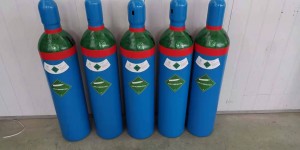Laser mixed gas refers to a working medium formed by mixing multiple gases in a certain proportion to achieve specific laser output characteristics during the laser generation and application process. Different types of lasers require the use of laser mixed gases with different components. The following is a detailed introduction for you:
Common types and applications
CO2 laser mixed gas
Mainly composed of carbon dioxide (CO2), nitrogen (N2) and helium (HE). In the field of industrial processing, such as cutting, welding and surface treatment, carbon dioxide lasers are widely used. Among them, carbon dioxide is the key substance for generating lasers, nitrogen can accelerate the energy level transition of carbon dioxide molecules and increase the laser output power, and helium helps to dissipate heat and maintain the stability of gas discharge, thereby improving the quality of laser beams.
Excimer laser mixed gas
Mixed from rare gases (such as argon (AR), krypton (KR), xenon (XE)) and halogen elements (such as fluorine (F), chlorine (CL)), such as ARF, KRF, XeCl, etc. This type of laser is often used in photolithography technology. In semiconductor chip manufacturing, it can achieve high-resolution graphic transfer; it is also used in ophthalmic surgery, such as excimer laser in situ keratomileusis (LASIK), which can accurately cut corneal tissue and correct vision.
Helium-neon laser gas mixture
It is a mixture of helium and neon in a certain ratio, usually between 5:1 and 10:1. Helium-neon laser is one of the earliest gas lasers, with an output wavelength of 632.8 nanometers, which is red visible light. It is often used in optical demonstrations, holography, laser pointing and other fields, such as alignment and positioning in construction, and also in barcode scanners in supermarkets.
Precautions for use
High purity requirements: Impurities in the laser gas mixture will affect the laser output power, stability and beam quality. For example, moisture will corrode the internal components of the laser, and oxygen will oxidize the optical components and reduce their performance. Therefore, the gas purity usually needs to reach more than 99.99%, and special applications even require more than 99.999%.
Accurate ratio: The ratio of each gas component has a significant impact on laser performance, and the exact ratio must be strictly in accordance with the laser design requirements. For example, in a carbon dioxide laser, changes in the ratio of nitrogen to carbon dioxide will affect the laser output power and efficiency.
Safe storage and use: Some laser mixed gases are toxic, corrosive, or flammable and explosive. For example, the fluorine gas in the excimer laser is highly toxic and corrosive. Strict safety measures must be taken during storage and use, such as using well-sealed storage containers, equipped with ventilation equipment and gas leak detection devices, etc.
Post time: May-22-2025












